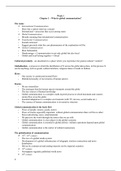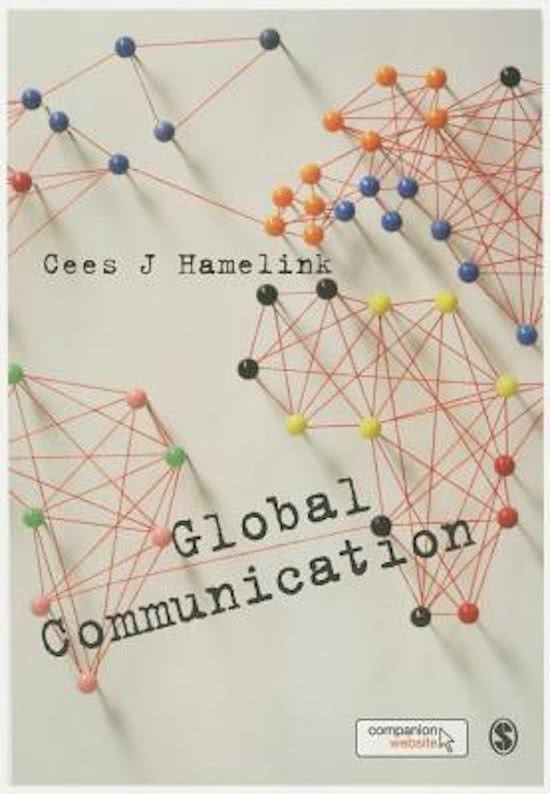Week 1
Chapter 1 – What is global communication?
The name
International Communication
- More like a nation-state key concept
- International = processes that occur among states
World Communication
- Broader meaning than international communication
Transborder Communication
- Sounds awkward
- Suggest precisely what the core phenomenon of the exploration will be
Global Communication
- Most fashionable
- Disadvantage = Communication is not only global but also local
- Global and local belong together = Glocal
Cultural proximity - an attachment to a place where you experience the gratest cultural “comfort”
Globalisation - a process in which the distribution of X across the globe takes place, in this process X
can be anything, such as goods, cultural artefacts, religious ideas or trends in fashion.
Flows
- Our society is constructed around flows
- Multidirectionality of movements of human species
Stories
- We are storytellers
- The messages that the human species transports around the globe
- The key sources of human knowledge
- Global communication is a complex multi-layered process in which dominant and counter-
stories flow cross the globe
- Essential adaptation to a complex environment (with TV, movies, social media etc.)
- The essence of human communication is its narrative structure
Global communication is the basic flow
- Flows of people, money, goods, stories
- Flows of stories especially important without global communication there will be no other
flows (advertising, news, entertainment)
- We perceive the world through the stories that we are told
- Global communication is a key player in the global economy
- Global communication is essential to global politics military operations depend upon global
communication
- Global communication is the carrier of cultural expressions
The globalization of communication
18th / 19th century
- The rise of a global media system
- Development of a global infrastructure of telegraph, wireless connections and news
distribution
- Driven by commercial and trading interests not by imperial countries
19th century
- Newspapers regularly published world news
20th century
1
, - International propaganda
- Film industry emerged as an international medium
- Television satellites (1970) broke the principle of national sovereignty of broadcasting space
- Markets for products became global and advertising went overseas media products that could
easily globalize were news, cinema films, recorded music and TV serials.
- Television is the most potent influence in the media globalization process
21st century
- Today no global media, instead hybrid forms based upon national contexts (modus operandi)
- International media productions are localizing
- Increasingly economic interdependence but not media interdependence
- In spite of the globalising tendencies in the field of communication the national remains
essential The national level of media is still dominant in the countries where 90% of the
world's people reside
- Worldwide nationalism continues to be a crucial factor in both news and entertainment
- Hybridisation of cultures
The context of global Communication
- The study of global Communication requires contextualisation
- We need to understand the real-world environment to help this understanding we need a
conceptual framework that brings together the most characteristic dimensions of today world
Trans -localisation
- Globalisation the history
1. Ancient phase of globalisation
- Began with the journey of Homo sapiens
- Matured between 500 BC and AD 1500 with the silk roads that connected Asia with the
Mediterranean and parts of the Africa
- Distribution of the four great inventions in China (compass gunpowder paper making and
printing) to the West
- The export of Mathematics from the Arab countries.
2. A mercantilist colonial form of globalisation (between 1500 and 1800)
- Adventurous expeditions of the 16th century that explored and exploited the distant countries
- Forced foreign histories and religion upon indigenous people
3. A modern form of capitalist globalization (between 18th and 19th century)
- After the Industrial Revolution
- Enormous societal impact
4. Corporate globalization (after WW2)
- Pace and scope of global distribution processes rapidly increased
- The mobility of capital
- The consolidation of markets through global competition
- Global polarization between the industrial nations and the non-industrial nations / between the
centre and the periphery (the centre nations exercising control over periphery through five
monopolies of technology, finance, resources, weapons and communication)
5. Modern era of globalization (late 20th century)
- The scope of the globalization process boosted by technological innovations and the
emergence of institutions with global expansion on their agenda
- Interdependence
- The spread of modernity in politics, economy, and in culture
- Globalization the analytic tool
- The concept of globalization has its protagonists and also sceptics
- Protagonists = free market economies (capitalism) / Sceptics = true, but the economy is in
hands of few rich countries in the world
2
, - Protagonists = more global trading than ever before / Sceptics = most world trading is not
global but takes place within geographical regions
- Protagonists = the growth of financial markets, unprecedented global financial mobility /
Sceptics = agree, but stress that its only one type of capital and that financial mobility remains
limited, also rapid money causes serious risks for 3rd world economies
- Protagonists = increased global mobility of people / Sceptics = most people stay home
- Protagonists = Intensification of global consciousness / Sceptics = world is more a collection
of many local villages than one global village
- Protagonists = increasing economic interdependence leads to social interdependence,
integration / Sceptics = this lacks empirical confirmation, lots of people in the world do not
feel like a part of the “global family”, disintegration
- Protagonists = globalization as the inevitable consequence of modern technological
developments in transportation and communication / Sceptics = an explanation based upon
technological determinism is limited, technologies play a role, but the crucial variables are
decisions made by public and private institutions
- Protagonists = the financial capacities and political power of the major transnational
corporations (TNCs) have certainly increased / Sceptics = many powerful companies could
not survive without state subsidies or without the purchases by states from corporations for
defence purposes or for more general purposes, the role of law enforcement institutions is
crucial, TNCs need national governments
- Globalization the political programme
- Advocates = globalization creates worldwide, open and competitive markets which promote
global prosperity global free market leads to more employment, better quality of goods and
services, and lower consumer prices
- Critics = globalization agenda is a neo-liberal political programme that promotes the interests
of the world’s most powerful players – large number of farmers, workers, immigrants, youth
and women are negatively affected by economic globalization
- Advocates = see globalization as unstoppable and beneficial
- Critics = disagree, if there is globalization, then globalization means poverty
- Advocates = globalization promotes cultural differentiation
- Critics = claim that its merely a new disguise for old-fashion imperialism
Urbanisation
- 21st century human species became an “urban species” 70% of the population living in cities
- Global cities becoming the world’s centres of finance, fashion, the arts, and the media
- Key hubs in global economic and key actors in current process of globalization
- Centres of money, high finance, culture – variety of cultural roles emerged (spectatorship,
tourism, performance and sales)
- Key places for all kinds of services (legal assistance, marketing, advertising and architecture)
- Heterogeneity – the city is a place of heterogeneity a place of differences, dealing with the
permanent provocation that the heterogeneity poses is exceedingly difficult for many people
- Speed – the city is characterized by the tremendous speed of its movements and interactions,
social interactions demand time and for most city dwellers this means that they have to learn
how to slow down
- Mindlessness – much of urban interaction is mindless
Institutionalization
- We search for adequate responses to complex problems – they stem from human experiences
(desire to grow, learn, communicate or the concern about pain, suffering and death)
- A wide range of institutions have been developed in a search for these adaptive responses and
to satisfy our basic needs
- Education, health care, public communication
- Institutionalization = social process of embedding human needs, ideas, values and desires in
organizational formats with objectives, structures, sets of rules, and procedures for assessment
3







